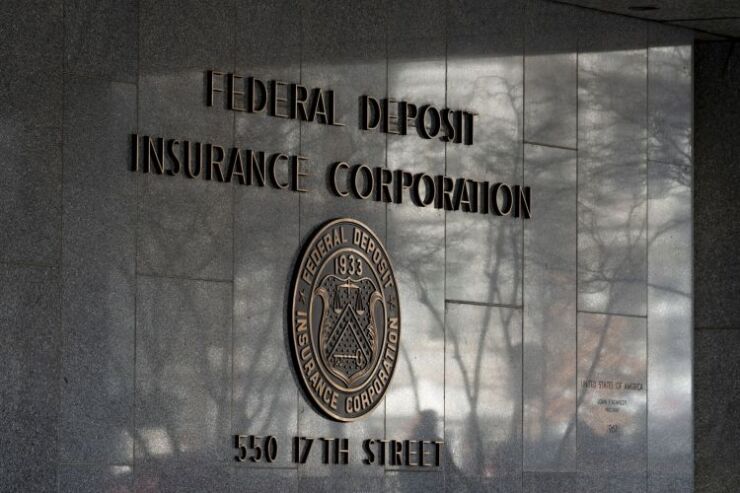
A postmortem report commissioned by the Federal Deposit Insurance Corp.'s Office of the Inspector General found examiners gave the troubled Republic First Bancorp a regulatory reprieve five months before it
The 39-page report, composed by Sikich, an Alexandria, Virginia-based certified public accounting firm, heaped much of the blame for Philadelphia-based Republic First's failure on its board and management. Distracted by a
By contrast, Sikich found that supervision of Republic First by FDIC and other agencies was "generally timely, adequate, and well-coordinated," — until FDIC appeared to turn away from decisive regulatory action as a result of a crucial November 2023 visitation. It's reasons for doing so, moreover, weren't properly laid out, Sikich stated.
Prior to the crucial Nov. 20 visitation, FDIC was poised to downgrade the $6 billion-asset Republic First's composite CAMELS rating to 5 — the worst possible score — and implement a consent order that had been drafted and approved by the regional director responsible for Republic First's supervision. Indeed, in an Oct. 10 memorandum, officials characterized Republic First as a "significant risk to the deposit insurance fund," adding "failure is highly probable."
Under CAMELS, regulators assess six key areas of a bank's operation to evaluate its overall condition. A rating of 5 denotes weak performance, inadequate risk management practices and the highest degree of supervisory concern, a Federal Reserve Bank of St. Louis CAMELS primer explained.
Six weeks later, however, in the wake of a Nov. 20 visitation, FDIC officials recommended the planned consent order be converted into a less-severe memorandum of understanding. And far from downgrading Republic First's CAMELS rating, they upgraded the Management component score from 4 to 3. In a memorandum drafted after the visitation, examiners wrote that "the bank's management team took considerable actions to navigate a challenging and dynamic liquidity stress event and made concerted efforts to address legacy weaknesses… Although additional efforts are needed to return the institution to an overall satisfactory condition, positive developments are noted."
It amounted to a significant 11th-hour U-turn backed by inadequate supporting documentation, according to Sikich. "The limited information documented did not provide a clear trail of decisions and supporting logic," the report stated. "The available evidence we reviewed suggested that downgrades of other component ratings and sustainment of the Management rating may have been warranted at the time the FDIC upgraded Republic Bank's Management component rating," the firm noted in its report.
According to Bert Ely, a veteran banking consultant who studies failed banks and thrifts, the Sikich report raises questions about FDIC decision making. "Why was the FDIC, and possibly other regulators, so slow in coming to grips with the bank's very obvious and very serious financial and operational problems," Ely said. "Delay and foot-dragging have been endemic in banking supervision for as long as I have been monitoring the process…It just boggles the mind that we continue to see these incredible delays in acting."
Poor management features in virtually every bank failure, Ely added. "There's usually an enormous amount of negligence on the part of management and the board," he said.
FDIC, to be sure, did ultimately downgrade Republic First's composite CAMELS rating to 5 in March 2024. The bank failed about a month later, on April 26, costing FDIC's Deposit Insurance Fund $667 million. Furthermore, in the six months between October 2023, when the consent order and the composite-5 CAMELS rating were being considered, and Republic First's ultimate failure, the estimated claim associated with the bank's insured depositors increased nearly $500 million, to $2.5 billion.
"The passage of time didn't do them any favors from a loss standpoint," Ely said. "I would hope, particularly given the magnitude of this loss, [Congress] would take a look at the supervision in this situation."
In its report, Sikich included a series of recommendations. The firm advised FDIC to revise its manual to ensure examiners provide sufficient documentation to support supervisory decisions. It also advised FDIC to create a formal process to guide any action where a stronger regulatory action is replaced with a less-severe one.
For its part, FDIC stated it would review recommendations Sikich made in its report. FDIC also highlighted the fact that the bottom-line cause of Republic First's failure, according to Sikich, was the bank's realization in March that it would have to sell much of its securities portfolio at a loss in order to repay maturing Federal Home Loan Bank advances and other borrowing. The resulting transactions would have left Republic First critically undercapitalized.
An FDIC spokesman declined to comment further.






